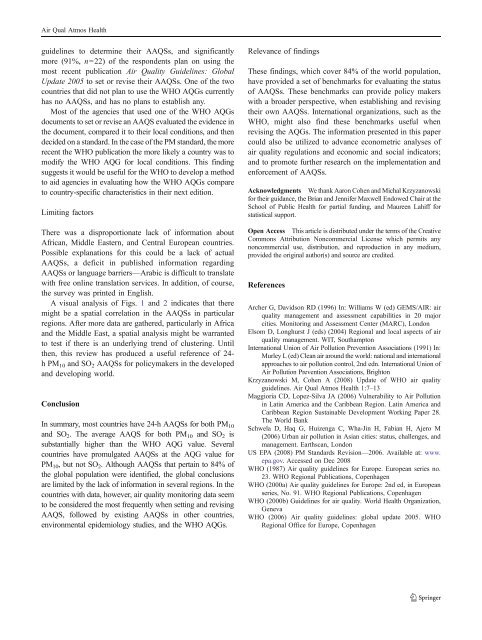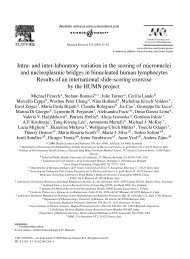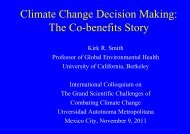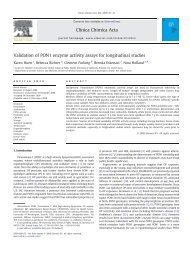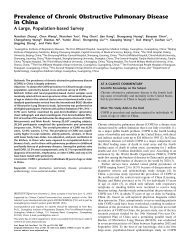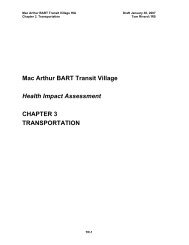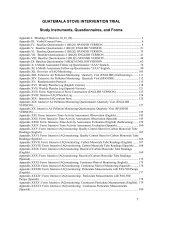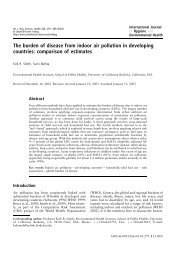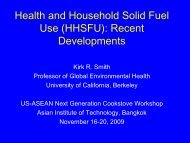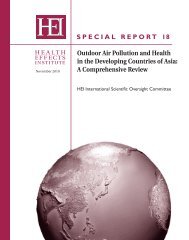Global review of national ambient air quality standards for PM10 and ...
Global review of national ambient air quality standards for PM10 and ...
Global review of national ambient air quality standards for PM10 and ...
Create successful ePaper yourself
Turn your PDF publications into a flip-book with our unique Google optimized e-Paper software.
Air Qual Atmos Healthguidelines to determine their AAQSs, <strong>and</strong> significantlymore (91%, n=22) <strong>of</strong> the respondents plan on using themost recent publication Air Quality Guidelines: <strong>Global</strong>Update 2005 to set or revise their AAQSs. One <strong>of</strong> the twocountries that did not plan to use the WHO AQGs currentlyhas no AAQSs, <strong>and</strong> has no plans to establish any.Most <strong>of</strong> the agencies that used one <strong>of</strong> the WHO AQGsdocuments to set or revise an AAQS evaluated the evidence inthe document, compared it to their local conditions, <strong>and</strong> thendecided on a st<strong>and</strong>ard. In the case <strong>of</strong> the PM st<strong>and</strong>ard, the morerecent the WHO publication the more likely a country was tomodify the WHO AQG <strong>for</strong> local conditions. This findingsuggests it would be useful <strong>for</strong> the WHO to develop a methodto aid agencies in evaluating how the WHO AQGs compareto country-specific characteristics in their next edition.Limiting factorsThere was a disproportionate lack <strong>of</strong> in<strong>for</strong>mation aboutAfrican, Middle Eastern, <strong>and</strong> Central European countries.Possible explanations <strong>for</strong> this could be a lack <strong>of</strong> actualAAQSs, a deficit in published in<strong>for</strong>mation regardingAAQSs or language barriers—Arabic is difficult to translatewith free online translation services. In addition, <strong>of</strong> course,the survey was printed in English.A visual analysis <strong>of</strong> Figs. 1 <strong>and</strong> 2 indicates that theremight be a spatial correlation in the AAQSs in particularregions. After more data are gathered, particularly in Africa<strong>and</strong> the Middle East, a spatial analysis might be warrantedto test if there is an underlying trend <strong>of</strong> clustering. Untilthen, this <strong>review</strong> has produced a useful reference <strong>of</strong> 24-hPM 10 <strong>and</strong> SO 2 AAQSs <strong>for</strong> policymakers in the developed<strong>and</strong> developing world.ConclusionIn summary, most countries have 24-h AAQSs <strong>for</strong> both PM 10<strong>and</strong> SO 2 . The average AAQS <strong>for</strong> both PM 10 <strong>and</strong> SO 2 issubstantially higher than the WHO AQG value. Severalcountries have promulgated AAQSs at the AQG value <strong>for</strong>PM 10 ,butnotSO 2 . Although AAQSs that pertain to 84% <strong>of</strong>the global population were identified, the global conclusionsare limited by the lack <strong>of</strong> in<strong>for</strong>mation in several regions. In thecountries with data, however, <strong>air</strong> <strong>quality</strong> monitoring data seemto be considered the most frequently when setting <strong>and</strong> revisingAAQS, followed by existing AAQSs in other countries,environmental epidemiology studies, <strong>and</strong> the WHO AQGs.Relevance <strong>of</strong> findingsThese findings, which cover 84% <strong>of</strong> the world population,have provided a set <strong>of</strong> benchmarks <strong>for</strong> evaluating the status<strong>of</strong> AAQSs. These benchmarks can provide policy makerswith a broader perspective, when establishing <strong>and</strong> revisingtheir own AAQSs. Inter<strong>national</strong> organizations, such as theWHO, might also find these benchmarks useful whenrevising the AQGs. The in<strong>for</strong>mation presented in this papercould also be utilized to advance econometric analyses <strong>of</strong><strong>air</strong> <strong>quality</strong> regulations <strong>and</strong> economic <strong>and</strong> social indicators;<strong>and</strong> to promote further research on the implementation <strong>and</strong>en<strong>for</strong>cement <strong>of</strong> AAQSs.Acknowledgments We thank Aaron Cohen <strong>and</strong> Michal Krzyzanowski<strong>for</strong> their guidance, the Brian <strong>and</strong> Jennifer Maxwell Endowed Ch<strong>air</strong> at theSchool <strong>of</strong> Public Health <strong>for</strong> partial funding, <strong>and</strong> Maureen Lahiff <strong>for</strong>statistical support.Open Access This article is distributed under the terms <strong>of</strong> the CreativeCommons Attribution Noncommercial License which permits anynoncommercial use, distribution, <strong>and</strong> reproduction in any medium,provided the original author(s) <strong>and</strong> source are credited.ReferencesArcher G, Davidson RD (1996) In: Williams W (ed) GEMS/AIR: <strong>air</strong><strong>quality</strong> management <strong>and</strong> assessment capabilities in 20 majorcities. Monitoring <strong>and</strong> Assessment Center (MARC), LondonElsom D, Longhurst J (eds) (2004) Regional <strong>and</strong> local aspects <strong>of</strong> <strong>air</strong><strong>quality</strong> management. WIT, SouthamptonInter<strong>national</strong> Union <strong>of</strong> Air Pollution Prevention Associations (1991) In:Murley L (ed) Clean <strong>air</strong> around the world: <strong>national</strong> <strong>and</strong> inter<strong>national</strong>approaches to <strong>air</strong> pollution control, 2nd edn. Inter<strong>national</strong> Union <strong>of</strong>Air Pollution Prevention Associations, BrightonKrzyzanowski M, Cohen A (2008) Update <strong>of</strong> WHO <strong>air</strong> <strong>quality</strong>guidelines. Air Qual Atmos Health 1:7–13Maggioria CD, Lopez-Silva JA (2006) Vulnerability to Air Pollutionin Latin America <strong>and</strong> the Caribbean Region. Latin America <strong>and</strong>Caribbean Region Sustainable Development Working Paper 28.The World BankSchwela D, Haq G, Huizenga C, Wha-Jin H, Fabian H, Ajero M(2006) Urban <strong>air</strong> pollution in Asian cities: status, challenges, <strong>and</strong>management. Earthscan, LondonUS EPA (2008) PM St<strong>and</strong>ards Revision—2006. Available at: www.epa.gov. Accessed on Dec 2008WHO (1987) Air <strong>quality</strong> guidelines <strong>for</strong> Europe. European series no.23. WHO Regional Publications, CopenhagenWHO (2000a) Air <strong>quality</strong> guidelines <strong>for</strong> Europe: 2nd ed, in Europeanseries, No. 91. WHO Regional Publications, CopenhagenWHO (2000b) Guidelines <strong>for</strong> <strong>air</strong> <strong>quality</strong>. World Health Organization,GenevaWHO (2006) Air <strong>quality</strong> guidelines: global update 2005. WHORegional Office <strong>for</strong> Europe, Copenhagen


